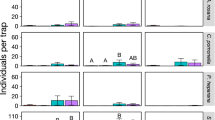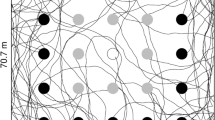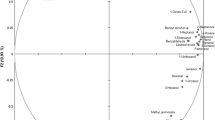Abstract
Responses of non-target insects to a blend of plant volatiles used as components in an attract-and-kill formulation for Helicoverpa spp. (Lepidoptera: Noctuidae) were studied in an Australian cotton field. Two experiments, one involving suction sampling during the day and the other at night, were conducted. Rows that had been treated with the volatile blend, with no added insecticide, were sampled with a large suction sampler 18, 42, and 85 h (day experiment) and 6, 30, and 78 h (night experiment) after treatment. Rows located 5, 10, 20, and 300 m away from the treated row were similarly sampled. Of seven generalist predators, only one accumulated on the treated rows compared to the untreated rows. Of the other six, five were found in lower numbers on the treated rows, and for one no significant effects were detected. Compared to pre-spray baseline levels, numbers of several taxa increased across the whole field after spraying, suggesting area-wide attraction, but localized responses to the treated rows were weak, and apparent repellence was more common than attraction. We suggest that attract-and-kill with plant volatiles should have minimal effects on populations of these predators, and is likely to be compatible with integrated pest management.









Similar content being viewed by others
References
Biondi A, Mommaerts V, Smagghe G, Vinuela E, Zappala L, Desneux N (2012) The non-target impact of spinosyns on beneficial arthropods. Pest Manag Sci 68:1523–1536
Bruce TJ (2000) The olfactory basis for attraction of the bollworm Helicoverpa armigera (Hübner) (Lepidoptera: Noctuidae) to host-plant flowers. PhD Thesis, University of Greenwich.
Bruce TJA, Wadhams LJ, Woodcock CM (2005) Insect host location: A volatile situation. Trends Plant Sci 10:269–274
Del Socorro AP, Gregg PC, Alter D, Moore CJ (2010a) Development of a synthetic plant volatile-based attracticide for female noctuid moths. I. Potential sources of volatiles attractive to Helicoverpa armigera (Hübner) (Lepidoptera: Noctuidae). Aust J Entomol 49:10–20
Del Socorro AP, Gregg PC, Hawes AJ (2010b) Development of a synthetic plant volatile-based attracticide for female noctuid moths. III. Insecticides for adult Helicoverpa armigera (Hübner) (Lepidoptera: Noctuidae). Aust J Entomol 49:31–39
Deutscher S, Wilson L, Mensah R (2005) Integrated pest management guidelines for cotton production systems in Australia. Australian Cotton CRC, Narrabri, Australia.
Franzmann B (2002) Hippodamia variegata (Gioeze) (Coleoptera: Coccinellidiae), a predacious ladybird new in Australia. Aust J Entomol 41:375–377
Gilles M, Zhao J, An M, Agboola S (2010) Chemical composition and antimicrobial properties of essential oils of three Australian Eucalyptus species. Food Chem 119:731–737
Gregg PC, Greive KA, Del Socorro AP, Hawes AJ (2010a) Research to realisation: The challenging path for novel pest management products in Australia. Aust J Entomol 49:1–9
Gregg PC, Del Socorro AP, Henderson GS (2010b) Development of a synthetic plant volatile-based attracticide for female noctuid moths. II. Bioassays of synthetic plant volatiles as attractants for the adults of the cotton bollworm, Helicoverpa armigera (Hübner) (Lepidoptera: Noctuidae). Aust J Entomol 49:21–30
Hothorn T, Bretz F, Westfall P (2008) Simultaneous inference in general parametric models. Biom J 50:346–363
Kumar P, Mishra S, Malik A, Satya S (2014) Biocontrol potential of essential oil monoterpenes against housefly, Musca domestica (Diptera: Muscidae). Ecotoxicol Environ Saf 100:1–6
Landolt PJ, Smithhisler CL, Zack RS, Camelo L (2006) Attraction of Heliothis belladonna (Henry and Edwards) to the sex pheromone of the corn earworm moth, Helicoverpa zea (Boddie) (Lepidoptera: Noctuidae). J Kansas Entomol Soc 79:303–308
Landolt PJ, Adams T, Zack RS, Crabo L (2011) A diversity of moths (Lepidoptera) trapped with two feeding attractants. Ann Entomol Soc Am 104:498–506
Landolt PJ, Toth M, Meagher RL, Szarukan I (2013) Interaction of acetic acid and phenylacetaldehyde as attractants for trapping pest species of moths (Lepidoptera: Noctuidae). Pest Manag Sci 69:245–249
Lopez JD, Lingren PD (1994) Feeding response of adult Helicoverpa zea (Lepidoptera:Noctuidae) to commercial phagostimulants. J Econ Entomol 87:1653–1658
Lopez JD, Latheef MA, Hoffmann WC (2011) Mortality and reproductive effects of ingested spinosad on adult bollworms. Pest Manag Sci 67:220–225
Mensah RK, Macpherson I (2010) Lure-and-kill as reduced-risk strategy for managing Helicoverpa spp. on conventional cotton crops within transgenic cotton fields. J Biocontrol 24:91–103
Mensah RK, Gregg PC, Del Socorro AP, Moore CJ, Hawes AJ, Watts N (2013) Integrated pest management in cotton: Exploiting behaviour-modifying (semiochemical) compounds for managing cotton pests. Crop Pasture Sci 64:763-773
Pyke BA, Brown EH (1996) The cotton pest and beneficial guide. Cotton Research and Development Corporation, Narrabri, Australia, p 51
R Core Team (2015) R: A language and environment for statistical computing. R Foundation for Statistical Computing, Vienna, Austria URL https://www.R-project.org/. Accessed 15 January 2016
Skiri HT, Stranden M, Sandoz JC, Menzel R, Mustaparta H (2005) Associative learning of plant odorants activating the same or different receptor neurones in the moth Heliothis virescens. J Exp Biol 208:787–796
Stanley JN (1997) The seasonal abundance and impact of predatory arthropods on Helicoverpa spp. in Australian cotton fields. Ph.D. thesis, University of New England, Armidale, Australia.
Stranden M, Rostelien T, Liblikas I, Alamaas T, Borg-Karlson A, Mustaparta H (2003) Receptor neurones in three heliothine moths responding to floral and inducible plant volatiles. Chemoecology 13:143–154
Venables WN, Ripley BD (2002) Modern Applied Statistics with S, Fourth edn. Springer, New York
Wilson L, Downes S, Khan M, Whitehouse M, Baker G, Grundy P, Maas S (2013) IPM in the transgenic era: A review of the challenges from emerging pests in Australian cotton systems. Crop Pasture Sci 64:737–749
Witzgall P, Kirsch P, Cork A (2010) Sex pheromones and their impact on pest management. J Chem Ecol 36:80–100
Acknowledgments
We are indebted to Rodney Dunlop for assistance with the suction sampling studies. The Australian Cotton Cooperative Research Centre provided funding and access to the field site, and AgBiTech Pty Ltd. provided the plant volatile formulation.
Author information
Authors and Affiliations
Corresponding author
Rights and permissions
About this article
Cite this article
Gregg, P.C., Del Socorro, A.P. & Binns, M.R. Non-Target Impacts of an Attract-and-Kill Formulation Based on Plant Volatiles: Responses of some Generalist Predators. J Chem Ecol 42, 676–688 (2016). https://doi.org/10.1007/s10886-016-0727-6
Received:
Revised:
Accepted:
Published:
Issue Date:
DOI: https://doi.org/10.1007/s10886-016-0727-6




